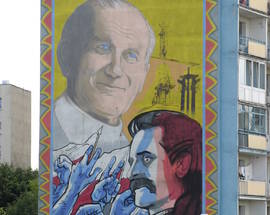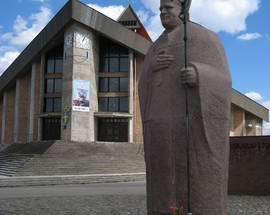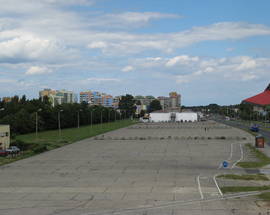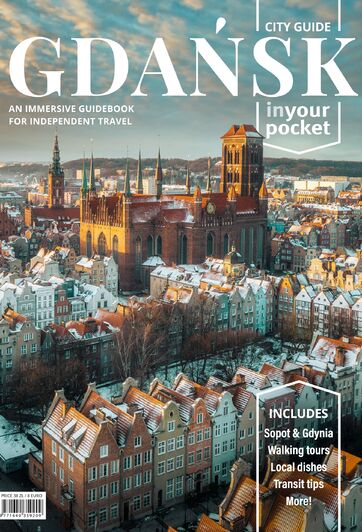The Pope in Gdansk
more than a year agoThis was the Pope’s third visit to his homeland in the 9 years since he had become Pope but the first to the city of Gdansk which had given birth to Solidarity. The union was now classed as an illegal organization while Zaspa was home to Lech Walesa and to many of the workers from the 1980 shipyard strike. The Poland that the Pope came to in 1987 was very different to the one he had visited most recently in 1983. The enthusiasm and believe for and in Solidarity was waning. People were losing faith in the movement ever being able to change anything and many were taking their own directions. These directions often lead abroad and in this period over 700,000 people left Poland. Not a significant number you might think bearing in mind that in the 3 years following EU accession up to four times this many left to work and live abroad. But this was communist Poland. Most left illegally driven by the desire for a new life and opportunity. There had also been a successful propaganda campaign carried out by the authorities and reforms had been made although most were of no consequence to everyday life. But Solidarity and the anti-government campaigns were at a low ebb. So the message the Pope brought with him was one of the need for faith, belief, unity and solidarność (solidarity).
The mass, celebrated on the 12th of June 1987, was dedicated to workers. Over a million people attended the mass set on the remains of the old airstrip in the centre of the Zapsa district. The altar, designed by Marian Kołodziej and resembling a ship with a 5 metre tall figure of St Peter at its bow, was a magnificent construction of wood and steel which took 6 weeks to build. It should be remembered that this was a Poland of huge shortages yet the construction would have been considered incredible in a prosperous country. Materials were gathered from all over Poland, from Catholics and non-believers alike. False documentation was acquired allowing access to resources, materials donated, equipment ‘acquired’ and labour provided free of charge. A crane supposedly on loan to carry out work in Gdynia was ‘borrowed’ to help assemble the altar. The final construction was itself a snub to the authorities as it had no planning permission. The result was breathtaking. The Pope, standing on the deck of the ship 15m in the air and with crosses, the tallest of which was 38m high, behind him like masts complete with 400m2 sails could be seen by the entire congregation stretching back hundreds of metres from the altar.
The mass gave the people renewed strength to carry on the fight for change. The Pope repeatedly appealed to his congregation that together people are stronger than if they are apart. In thinly disguised language he urged the people of Gdansk and Poland that as Catholics and as citizens they should remain united, they should share the burden and that this would bring them victory. The Pope told the people to think of one another and that a person could not live alone (‘Czlowiek nie jest sam zyje z drugimi, przez drugich, dla drugich’ – ‘ A person is not alone he lives with others, through others, for others). The message was clear. Feel solidarity, show solidarity with one another. The heavier the burden, then the greater the need for people to show solidarity with one another. He also preached a message of non-violence asking the Poles to not fight with their enemies but to work together to seek consensus and compromise. Together the people had to think over how to cooperate with each other so that together they could share their common burdens. His key message was that there was no struggle which could not be beaten together. (‘Walka nigdy nie moze byc silniejsza od solidarnosc’ – The fight can never be stronger than solidarity’).
The message preached by the Pope was full of double meaning but his constant reference to Poles' solidarity with each other was a very thinly disguised message to support Solidarity as they sought a path to freedom.
Lech Walesa was in attendance although he would not have been if the authorities would have had their way. Father Krzysztof Wojciechowski of the parish of the Divine Providence in Zaspa was a rector at the mass all those years ago. He remembered Lech Walesa coming to the presbytery of the church on the morning of the mass as he was worried he was about to be picked up by the authorities. He spent the day hiding in the church before the priests smuggled him through the crowds and close to the altar before the mass.
Reminiscences of the time also both highlight the atmosphere of the time and gives rise to what now can be considered funny episodes. One such example is the authority’s attempts to use the event to spread communist propaganda. A few weeks before the mass was due to take place communist slogans started to appear on the sides of building overlooking the area where mass was to be held. These included ‘Bylismy, jestesmy, bedziemy – we were, we are, we will be’ and ‘nasza praca ojczyźnie – Our work is for the Fatherland’. Priests quickly organized ‘decorating committees’ to brighten up the buildings and to try to negate these pro-communist messages. They achieved this not by defacing or removing the slogans but by adding words to them to change the meaning. The first slogan above had the words ‘zawsze wierni Bogu' (always believing in God) added while the second had the words ‘i Bogu' (and God) tacked on the end on painted sheets. Father Wojciechowski commented that the people in authority were ‘so smart’ that they put the signs up three weeks ahead of the mass rather than the night before when the decorating committees would not have had enough time to change them.
The Pope also said mass in Gdynia during his visit as well as meeting the sick in St Mary’s Basilica in Gdansk, meeting the young at Westerplatte and giving prayers in Oliwa Cathedral. A photograph of the Pope praying alone at the Monument to the Fallen Shipyard Workers during this visit can be seen at the gates to the Gdansk Shipyard. After the mass the altar was dismantled and the materials used in a number of churches in the Gdansk area. The crosses now form part of the church of Sw. Kazimierza (St. Cashimir – ul. Pilotow 1) and the Divine Providence church (Al. Jana Pawla II 48). A stone was placed to mark the spot where the mass was celebrated but it mysteriously disappeared the following year probably on the orders of the authorities. The park and the main road have instead both now been named in honour of Jana Pawla II (Pope John Paul II), while a lot of the area where the congregation stood has now been covered by modern apartment buildings.
Today Zaspa is a huge relic of socialist housing policy. Blocks stretch for miles in every direction although the greyness of socialist days has now been replaced by a huge redecorating program resulting in a panorama of multi-coloured blocks. The church of the Divine Providence stands in the centre of this on al. Jana Pawla II and outside can be found a statue of the Polish Pope designed by Prof. Mariusz Kulpa and unveiled on the 4th of June 1999. The church is still a work in progress though open to the public. It contains two churches. On the ground floor is the current parish church with the altar and rostrum used that day in 1987. Upstairs is a huge church which contains both the throne used by the Pope in 1987 and a 25 metre high cross with a beautiful heart-shaped steel and amber sculpture at its foot from which grows a tree of life. The church is to be consecrated as St John Paul’s now the expected canonization of the Pope has been confirmed.
Father Wojciechowski created up a small exhibition on the Pope’s visit of 1987 inside of the church and though still a work in progress it is worth taking a few minutes to view the pictures of the event to get a taste of how important this was to the people of Gdansk. The Pope returned to his homeland at a crucial time and his influence and importance on the downfall of communism is often overlooked. It is said that his first visit to Poland after he became Pope, when he preached 32 sermons in 9 days, created a psychological earthquake and throughout the 1980s the people of Poland drew strength from ‘their man’ in the Vatican. But this visit to Gdansk in 1987 can be seen as pivotal in the fight of the Polish people against the communist system and the Pope’s ability to help the people, his people, re-group and find renewed strength for the fight was a major factor in the Poles achieving talks at the ‘Round Table’ a little under 2 years later. The Pope’s closing message to his people at the mass sum up his feelings and message.
‘So my dear brothers and sisters I finish, I finish now with the promise of a prayer, an internal bond, a spiritual bond with my homeland and with you, with people of work, with all those just and noble aims which strive to make human’s lives through work more human, more dignified, to renew the face of the land, our Polish land, just as I prayed during my first pilgrimage at Pl. Zywiecstwa in Warsaw (in 1979) asking the Holy Spirit to come down and renew the face of the land, this land.’
/gdansk/gate-2-of-the-gdansk-shipyard_130042v
The #2 gate of the Gdańsk Shipyard is where Lech Wałęsa stood to announce to the waiting crowd
/gdansk/monument-to-the-fallen-shipyard-workers-of-1970_16205v
Lying right outside famous Gate #2 to the Gdańsk Shipyard, the monument was unveiled in 1980 to commemorate the events of 1970 w






Comments